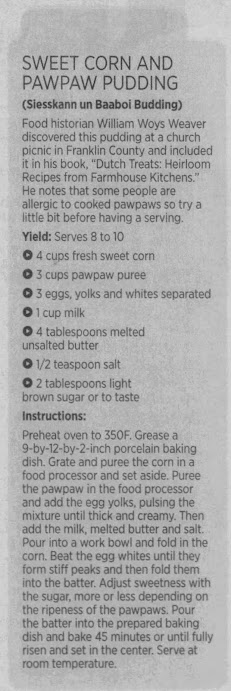Growing on trees all along the Susquehanna River Valley is a fruit referred to as a combination between a banana and a mango. It has many names, such as Hill Billy Mangos, Frost banana, Indiana banana, fetid-bush, bandango, custard apple, prairie banana, poor man's banana.
It's most commonly known as the Pawpaw, and they are native to the eastern United States.
The pawpaw tree is only a shrub, although in some conditions they may reach 30 or 40 feet tall, and a foot in diameter. Look for them in shaded woods areas near the river. In the summer, the trees will have beautiful dark blossoms.

The pawpaw season is short. The fruit ripens in September and October, and it is small, at about 3-5 inches long, and around half an inch in diameter. The texture of the pulp is creamy, avocado-like in texture. The fruit is ready to pick when they fall easily into your hand, or they fall to the ground, and old timers prefer that they do not look pretty. They should be a little black, like an overripe looking banana. A solid, or under-ripe pawpaw, not only will not taste good, but it can make you nauseous.
PawPaws have a short shelf life, and when they are ripe, they bruise easily. They can't be stored for long, and they can't be shipped long distances. Pawpaws begin to blacken just three days after they're picked, so if you cannot eat them quick enough, freeze the pulp for later use.
Pawpaw brandy was an old domestic industry "before Johnnie Apple's dad began the work of starting apple orchards".
https://www.facebook.com/PawpawFestYorkPA/
===================
Where To Find Them
- Trees were planted on Milton State Park in 2020
- Along the 1,000 steps trail, and near Dinky Station
- Appalachian Trail, east side of the river above Harrisburg
- In Abundance along Harpers Ferry - Loudon Heights Trail and Maryland Heights Trail
- The Pinnace on Kelly's Run
- List of Farms that sell them in Pennsylvania
Pawpaw Recipes:
=============
Pawpaws are indigenous to 26 states in the U.S., extending from northern Florida to Southern Ontario and as west as eastern Nebraska, according to KSU's Pawpaw Research Project.





No comments:
Post a Comment
I'll read the comments and approve them to post as soon as I can! Thanks for stopping by!